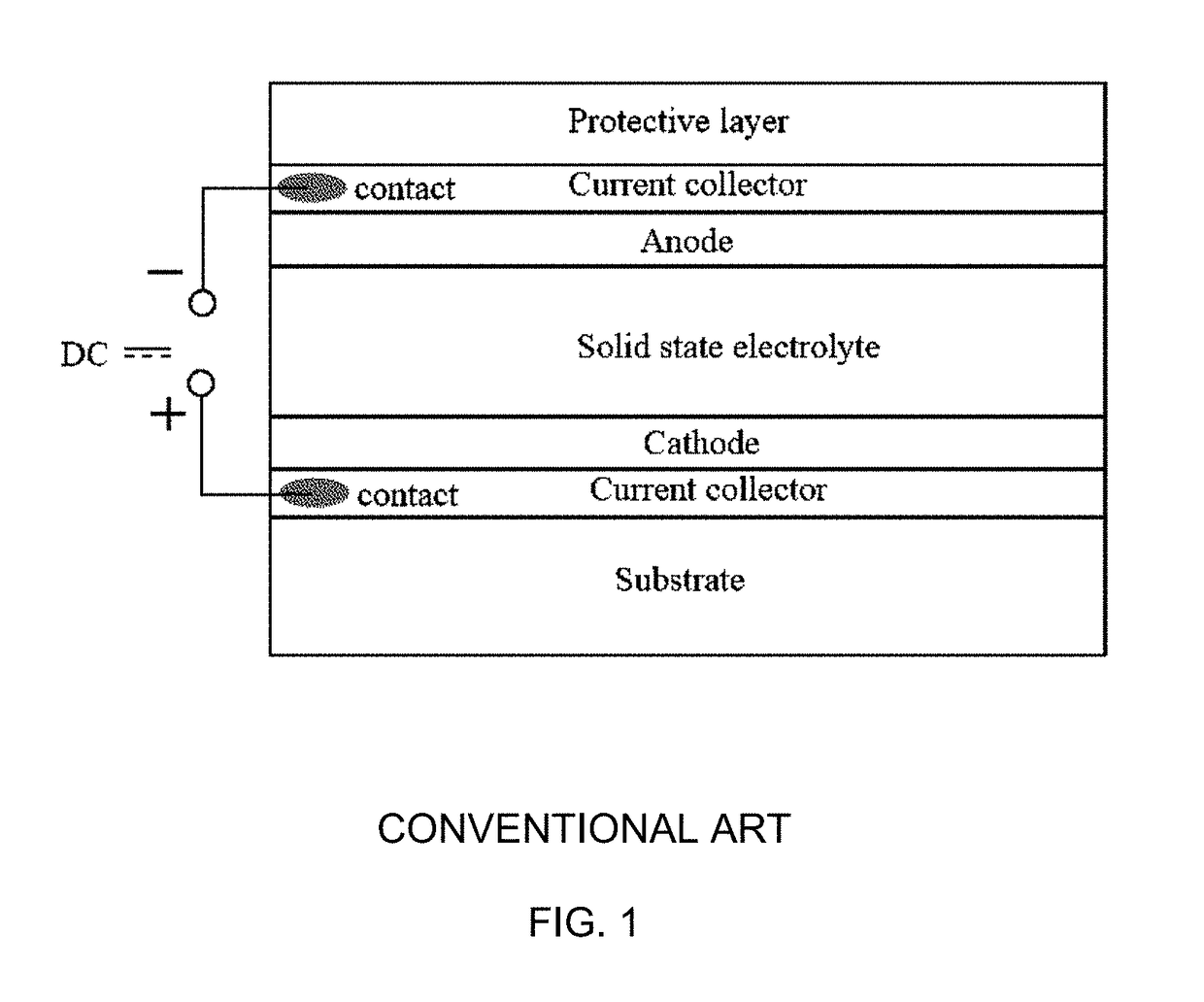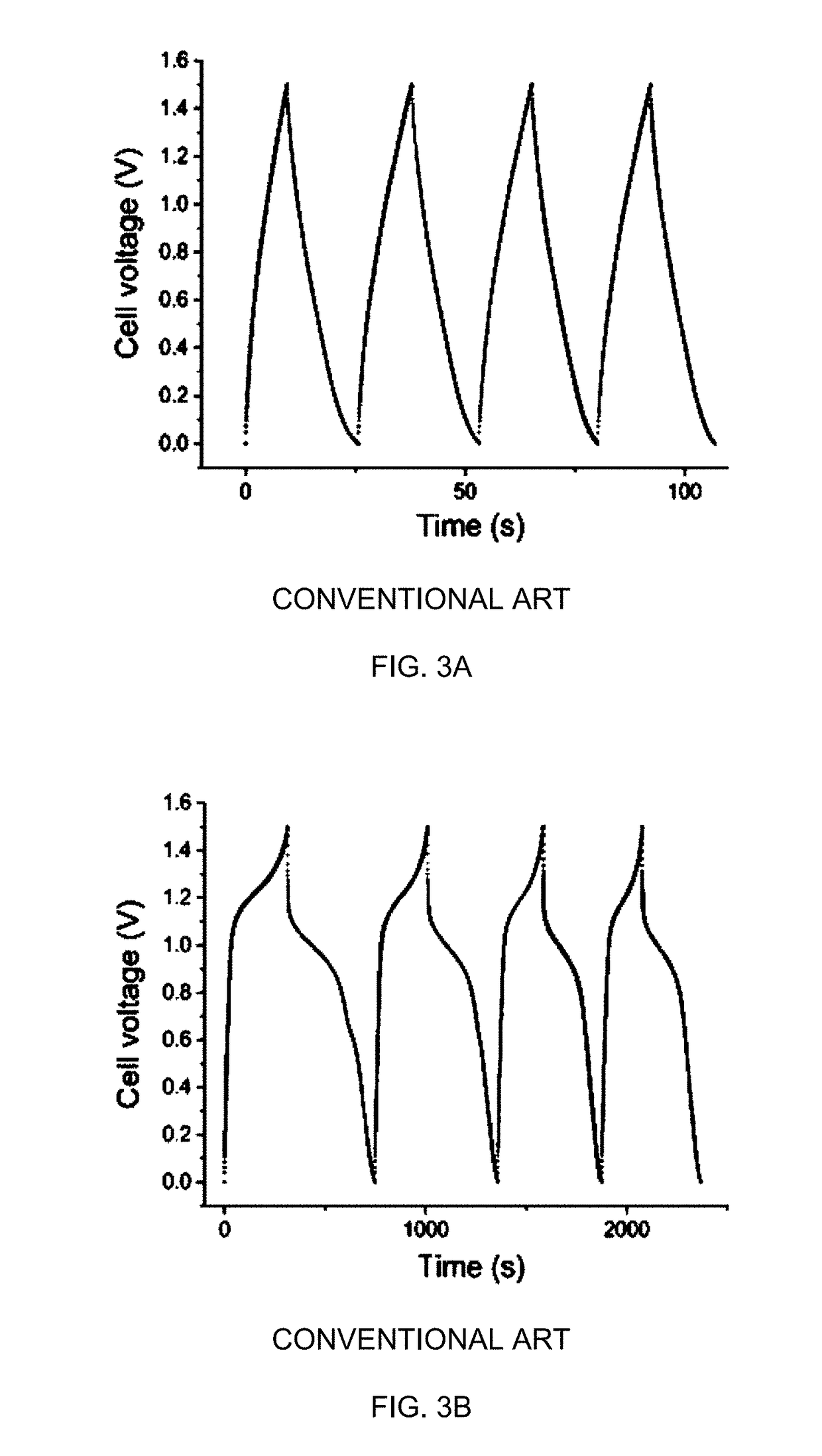Solid-state thin film hybrid electrochemical cell
a hybrid electrochemical cell and thin film technology, applied in the direction of electrochemical generators, electrochemical capacitors, electrical equipment, etc., can solve the problems that existing solid-state and semi-solid-state supercapacitors cannot meet all, wet supercapacitors cannot meet tough temperature requirements, and cannot be used for electric vehicles
- Summary
- Abstract
- Description
- Claims
- Application Information
AI Technical Summary
Benefits of technology
Problems solved by technology
Method used
Image
Examples
example 1
[0219]An AS-TF-SS-PSC sample having structure as shown in FIG. 8A with dimensions of 30×30 mm was built on a Si / SiO2 substrate using a sputtered 250 nm titanium layer as a bottom and top current collectors. The sample was manufactured using the above-indicated technology; two buffer / cache layers having thickness of 20 nm were made of Li0.8Ta1.2O3. Faradic layer WO2.4:Al:N:C (500 nm) was sputtered from three targets, W, Al and Graphite, in Ar / O2 / N2 atmosphere by PDC reactive magnetron co-sputtering. Solid state electrolyte layer (400 nm) was RF sputtered from a Li3PO4 target in pure N2 atmosphere at +150° C. The sputtered sample was annealed at 200-250° C. in nitrogen atmosphere. The final device was laminated by the same material as used for pouch Li-ion battery production to avoid contact with environment. Measurements were performed according to the above-described methods. The sample had OCV of 2.9 V and ESR of 26 Ohm for 9 cm2 sample and was operational in the temperature range ...
example 2
[0220]An AS-TF-SS-PSC sample having structure as shown in FIG. 8A with dimensions of 30×30 mm was built on a Si / SiO2 substrate using a sputtered 250 nm titanium layer as bottom and top current collectors. The sample was manufactured using the above-described technology; two buffer / cache layers having thickness of 20 nm were made of Li1.0Ta1.0O3. Faradic layer WO2.4:Al:N:C (500 nm) was sputtered from three targets, W, Al and Graphite, in Ar / O2 / N2 atmosphere by PDC reactive magnetron co-sputtering. Solid state electrolyte layer (400 nm) was RF sputtered from a Li3PO4 target in pure N2 atmosphere at +150° C. The sputtered sample was annealed at 200-250° C. in nitrogen atmosphere. The final device was laminated by the same material as for pouch Li-ion battery production to avoid contact with environment. Measurements were performed according to the above-described methods. The sample had OCV of 3.1 V and ESR of 21 Ohm for 9 cm2 sample and was operational in the temperature range of −50 ...
example 3
[0221]An AS-TF-SS-PSC sample having structure as shown in FIG. 8A with dimensions of 30×30 mm was built on a Si / SiO2 substrate using a sputtered 250 nm titanium layer as a bottom and top current collectors. The sample was manufactured using the above-described technology; two buffer / cache layers having thickness of 20 nm were made of Li1.4Ta1.0O3. Faradic layer WO2.4:Al:N:C (500 nm) was sputtered from three targets, W, Al and Graphite, in Ar / O2 / N2 atmosphere by PDC reactive magnetron co-sputtering. Solid state electrolyte layer (400 nm) was RF sputtered from a Li3PO4 target in pure N2 atmosphere at +150° C. The sputtered sample was annealed at 200-250° C. in nitrogen atmosphere. The final device was laminated by the same material as that used for pouch Li-ion battery production to avoid contact with environment. Measurements were performed according to the above-described methods. The sample had OCV of 3.3 V and ESR of 18 Ohm for 9 cm2 sample and was operational in the temperature r...
PUM
 Login to View More
Login to View More Abstract
Description
Claims
Application Information
 Login to View More
Login to View More - R&D
- Intellectual Property
- Life Sciences
- Materials
- Tech Scout
- Unparalleled Data Quality
- Higher Quality Content
- 60% Fewer Hallucinations
Browse by: Latest US Patents, China's latest patents, Technical Efficacy Thesaurus, Application Domain, Technology Topic, Popular Technical Reports.
© 2025 PatSnap. All rights reserved.Legal|Privacy policy|Modern Slavery Act Transparency Statement|Sitemap|About US| Contact US: help@patsnap.com



